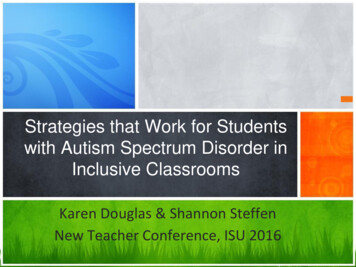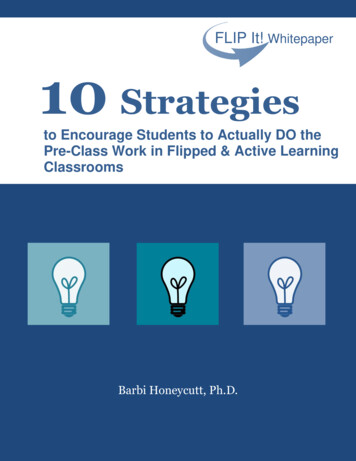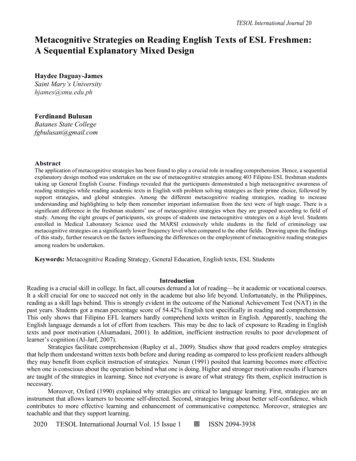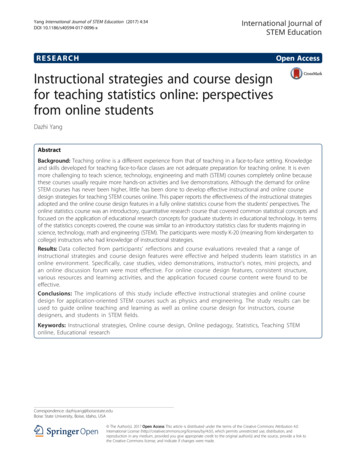
Transcription
Strategies that Work for Studentswith Autism Spectrum Disorder inInclusive ClassroomsKaren Douglas & Shannon SteffenNew Teacher Conference, ISU 2016
Today’s Goals Describe instructional strategies acrosscontent areas– No tech, low tech, and high tech examples Promote peer relationships
Core Strategies
Systematic Instruction Plan for the wait time and amount of helpneeded to correctly complete the task Errorless learning or limited errors Consistent instructionTypes of Systematic Instruction Constant time delay System of least prompts
Don’t forget to fade prompts!
Task AnalysisVisual Supports1. Gather the window cleaner and paper towels.2. Spray window cleaner on window or mirror.3. Wipe clean with paper towel.
Video Modeling v. Video Prompting Video Modeling– Student watches the entire task and then completesthe task Video Prompting– Task is broken down into separate steps– Student watches the video of the first step and thencompletes step 1– Student watches the second step and completesstep 2, and so on
UNIVERSAL DESIGN FOR LEARNING(UDL Principles)Multiple means of representation to give learners various ways of acquiringinformation and knowledge the “what” of learningMultiple means of expression to provide learners alternatives for demonstrating what theyknow the “how” of learningMultiple means of engagement to tap into learners' interests, offerappropriate challenges, and increase motivation the “why” of learning
Academic Supports
Double-Entry JournalAs you read the text, select a few phrases that you find meaningful or interesting.Write each phrase in the first column below, then write your reaction (a comment,question, connection made, or analysis) each quote in the second column.Page #From the textMy thoughts
Group WorkSeed Discussion–After writing ideas,discuss
PartnersPrediction Relay strategy allows each student to(1) make predictions about the assigned text,(2) take turns reading for 5 minutes,(3) check their predictions, and(4) summarize the main points.–“coach” and “player”Graphic Organizer
PartnersReciprocal Teaching - share the role of teacherby leading the discussion about a given reading. predicting question generating clarifying summarizingConcept map
Adapt Reading Materials (Hudson et al. 2013) Shorten the text Augment the text– audio, pictures, repeated line,links to definitions Use predictable structure Provide options for students to– demonstrate comprehension– express new vocabulary– write
Apps See Touch Learn Pro- 39.99 Splashtop-free iAnnotate- 9.99 Notability- 7.99 Quizlet-free JotNot Pro- 4.99 Show Me Interactive Whiteboard-free Dragon Dictation-free myHomework-free
Math Strategies
Problem Solving Strategies
Solve It! Problem-Solving Routine Cognitive and Meta-CognitiveProcesses (Montague, 2003)
Peer Relationships
Promote Peer Relationships - Natural SupportSocial Interactions Require: Proximity Opportunity Skills of students with and without disabilities
Proximity When are your students and their peerswithout disabilities in the same setting? Close proximity? Same activity?
Opportunity What can students and peers talk about? Social-related conversations– Mutual interests– School and community events Task-related conversations– Ask/answer questions– Discuss a topic What are peers talking about?
Skills of Students with Disabilities Communication skills– Verbal and nonverbal communication (device,pictures, gesture, sign language)– Initiate, maintain, & end conversations– Age-appropriate vocabulary
Skills of Students with Disabilities (cont’d) Social skills– Knowing when and how to interact appropriatelywith different people– Use and recognize social cues (e.g., bodylanguage, facial expression)– Good hygiene
Skills of Peers Ability awareness Allow time
Social Stories Describe a situation, skill, or concept in terms of relevantsocial cues, perspectives, and common responses–To teach social understanding–To help with the “unknown”–Help prepare for changes in routine or schedule–Describe educational goals–Describe appropriate behavior responses–To teach a new skill
Social Stories (cont’d) Ways to present social stories:–In a Word Document–On a decorated poster to hang on the wall–In Power Point–Using Photo Story–In the format of a book–Role-plays–Make a videoExample
Power Cards Using special interests of students with ASD has been effectivein classroom Power Card:–visual aid that utilizes a child’s special interest, hero,favorite character, or their favorite celebrity–Motivating–Non-threatening–Relies on relationship between student and their specialinterest
Shania Twain Greets Her FansShania Twain meets hundreds of people each year. Afterher concerts, she spends time with her fans, greeting them andautographing pictures. She used to hug all the people she metand then realized that this is not the only way, or the best way,to greet somebody she is meeting for the first time. Somepeople do not like to be hugged, especially by someone they aremeeting for the first time. Just like Shania, it is important foreverybody to learn to greet appropriately.
Shania is anxious to share these three points thatshe had learned about greeting people:1. Smile and put out your right hand and shake theother person’s right hand.2. Introduce yourself and ask how they are.3. Practice greetings with your friends and teachers.Following these steps will help you greet people justlike Shania!!
Real Relationships with Peers It’s the best gift you can give to your students
5 Essential Support Strategies1. Priming2. Academic modifications3. Home base4. Visual Supports5. ReinforcementFrom OAR – Organization for Autism uide.pdf
Resources National Professional Development Center on Autism Spectrum Disorders– ces The Center on Secondary Education for Students with Autism Spectrum Disorder– http://csesa.fpg.unc.edu/ Autism Internet Modules– http://www.autisminternetmodules.org/ Adolescent Literacy– http://www.adlit.org/strategy library/ Organization for Autism Research–http://www.researchautism.org/ UDL–http://www.udlcenter.org–http://www. cast. org
Resources Systematic Instruction for Students with Moderate and Severe Disabilitiesby Belva Collins Power cards: Using special interests to motivate children and youth withasperger syndrome and autism by E. Gagnon The new social story book by Carol ies/
Questions? Karen Douglas– kdougla@ilstu.edu Shannon Steffen– ssteffen@dunlapcusd.net
Strategies that Work for Students with Autism Spectrum Disorder in Inclusive Classrooms Karen Douglas & Shannon Steffen New Teacher Conference, ISU 2016 . Today’s Goals . achersGuide.pdf











